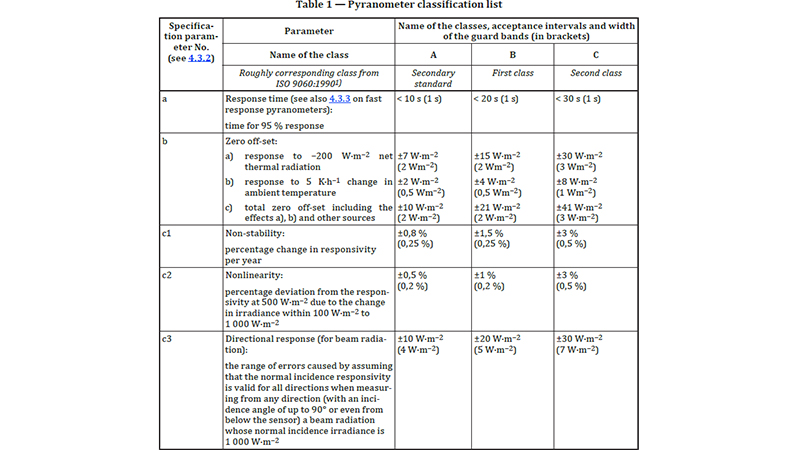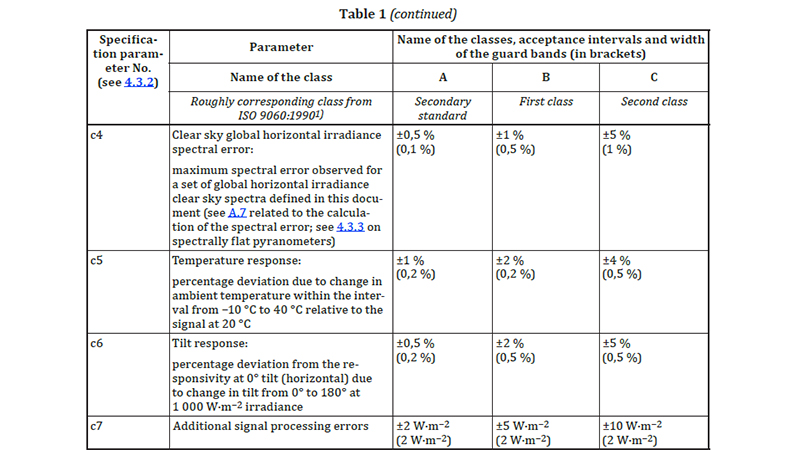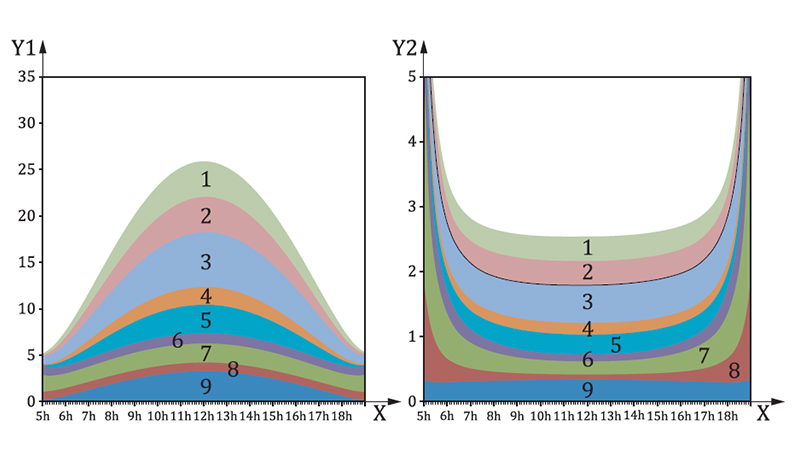Thermopile Pyranometers are highly accurate and sensitive sensors used to measure solar radiation in units of W/m2. In the most widely used fields, such as solar energy systems, meteorological observations and climate research, this sensor plays a critical role. The technical parameters that affect the accuracy of these devices are divided into specific classes according to the globally recognized ISO 9060:2018 standard.
SEVEN Class A Pyranometer and ISO-Compliant Technical Term Analysis
SEVEN Thermopile Pyranometer is a Class A Pyranometer according to ISO9060:2018. So how is Class A, which we constantly hear and see in Pyranometers, determined? This classification is based on various technical term analysis criteria. The characteristics of these technical terms will be explained in detail below.


“Table 1 – Pyranometer Classification List” is included in ISO9060:2018 standard. The table is used directly without any changes.”
-
Response Time
Indicates how fast the pyranometer responds to sudden changes in irradiance. It is usually used as “Response time (95%)” in technical documents. This means that, according to ISO 9060:2018, the tray time is the time required for the instrument to reach a stability of 95%.
-
Zero Offset
This is when the sensor deviates from zero even when the instrument is not receiving radiation. The term zero off-set is analyzed as the ability of the pyranometer to measure accurately in the dark. ISO 9060:2018 considers this error under three main headings:
- Zero offset a): Response to 200 W/m² net thermal radiation (dark signal), refers to the intrinsic drift of the sensor without exposure to ambient radiation.
- Zero offset b): Response to a temperature change of 5 K per hour (dark signal), indicates the sensor’s dark signal drift due to temperature change.
- Zero offset c): The total zero offset is expressed as the dark signal deviation due to the combined effects of both thermal radiation (zero offset a) and temperature change (zero offset b).
-
Non-Stability
It indicates how much the instrument deviates from its calibration, i.e. its sensitivity, over time. That is, the annual rate of change of the pyranometer sensitivity is defined as [%].
-
Non-Linearity
It measures the percentage deviation from the sensitivity, usually 500 W/m², caused by any irradiance change between 100 W/m² and 1000 W/m².
-
Directional Response
It is the change in the response of the pyranometers depending on the angle of incidence of the radiation. It is analyzed how the instrument’s sensitivity to radiation at different angles deviates from its normal (0°) sensitivity. These deviations lead to errors, especially when measurements are made under the assumption that the radiation is measured at the normal angle of incidence (90° zenith angle). Such errors are often referred to as “cosine error” and are discussed in detail in the ISO 9060:2018 standard. This is important for the accuracy of incoming radiation at low sun angles, such as in the morning and evening.
-
Spectral Error
Clear sky global horizontal irradiance spectral error is the characteristic that shows how the instrument’s response to different wavelengths over its operating range affects the total irradiance measurement. This error is evaluated under clear sky conditions in ISO 9060:2018.
-
Temperature Response
It is evaluated as a percentage of the maximum output error caused by changes in ambient temperature on the sensor output. This is evaluated from -10°C to +40°C against an output of 20°C according to ISO9060:2018.
-
Tilt Response
Tilt response is the error in the irradiance measurement as the tilt angle of the pyranometer changes. Technically, it is the percentage deviation from the sensitivity at 0 ̊ (horizontal) tilt due to changing the tilt from 0 ̊ to 180 ̊ at an irradiance of 1000 W/m².
-
Additional Signal Processing Errors
It specifies the deviations due to conversion, taking into account the potential measurement errors that occur in the process of converting the analog signals of pyranometers into digital signals.
Uncertainty in Solar Irradiance Measurements According to ISO 9901:2021
The ISO 9901:2021 standard addresses measurement uncertainties more comprehensively when setting performance criteria for pyranometers. This standard requires analyzing the sources of total measurement uncertainty, taking into account many factors such as instrument directivity, temperature response, non-linearity, data logger errors, etc. Figure 4 shows an example of an uncertainty analysis based on these criteria.
In the example shown in Figure 4, the Pyranometer measures the GHI at noon on a clear sunny day with an irradiance of about 1 000 W/m2. The distribution of the total uncertainty from different sources is shown on the left with the uncertainty expressed in W/m2 and on the right as a percentage of irradiance.

Figure 4 – Example of uncertainty evaluation using a spectrally flat Class A pyranometer
“Figure 4” is included in the ISO9901:2021 standard. It is used directly without any changes in the graphic.”
- X: Time (hours)
- Y1: U95 per uncertainty source, in W/m²
- Y2: U95, split per uncertainty source, as %
- 1; Maintenance
- 2; Temperature response
- 3; Directional response
- 4; Non-linearity
- 5; Non-stability
- 6; Zero offset B
- 7; Zero offset A
- 8; Data logger accuracy
- 9; Calibration uncertainty
The SEVEN 3S-TP-MB-A Spectrally Flat Class A Thermopile Pyranometer is the ideal choice for reliable measurements, offering high accuracy, low uncertainty and stable performance in harsh environmental conditions with technical specifications fully compliant with ISO9060:20218 international standard. SEVEN Thermopile Pyranometer stands out especially in terms of efficient operation of solar energy systems and obtaining consistent data in scientific research. 3S-TP-MB-A Spectrally Flat Class A Thermopile Pyranometer ” https://www.sevensensor.com/pyranometers “
